Fairey Gannet AEW.3
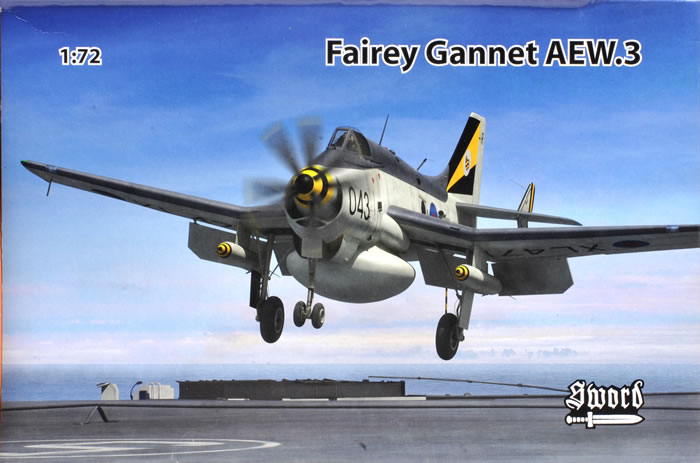
Sword, 1/72 scale
S u m m a r y : |
Catalogue Number: |
Sword Kit No. SW72088 – Fairey Gannet AEW.3 |
Scale: |
1/72 |
Contents & Media |
88 grey and four clear styrene parts, tone PE fret of seventeen pieces, one photo-foil, and decals for two subjects. |
Price: |
On-line stockists:
Click here for currency conversion. |
Review Type: |
First Look. |
Advantages: |
Very nice detail, accurate appearance, good production quality. Good value too, from the right supplier. |
Disadvantages: |
Raised strips on the fuselage and wing undersides are a bit exaggerated and a compromise in representing the surface detail portrayed. Some may choose to modify this whilst others will be happy with it. |
Conclusions: |
This is a very nicely executed kit of what is for me the best-looking Gannet (not hard! I hear you say).
Despite the slightly heavy-handed raised strips on the fuselage and wing undersides, it still ticks all of the right boxes. It has nice surface detail, better cockpit detail than is probably required, some very fine parts, clear instructions, and good decals.
Perhaps the best part for some is the price, which means they can buy a kit that essentially equals the superb Alley Cat resin kit at just over a quarter of the cost.
I highly recommend it. |
Reviewed by
Mark Davies

Sword's 1/72 scale scale Gannet AEW.3 is available online from
Squadron.com
The Gannet was designed to meet a requirement for a dedicated ship-borne Anti-Submarine Warfare (ASW) aircraft. The need was to combine both hunter and killer roles in one airframe, and retain a secondary anti-shipping strike capability. A notable feature of the design was the use of an Armstrong Siddeley Double Mamba turboprop engine. Two joined engines driving contra-rotating propellers provided for a compact streamlined installation, eliminated undesirable torque effects on take-off and landing, made for easy single engine handling, and allowed one engine to be shut down for economic cruise and loitering.
The US Navy realised the benefits of Airborne Early Warning (AEW) radar towards the end of WW2. AEW offered obvious advantages to seaborne air power. The Royal Navy first used US AEW radar carried by Douglas AD-4W Skyraiders. It was decided that a British AEW aircraft should be developed for the Royal Navy, and the Gannet was deemed the most suitable for development. The intention was to carry the same AN/APS-20 S-band (later re-designated E-band) radar as the Skyraiders.
The ASW Gannet fuselage was not suitable for the AEW role, especially as side-by-side seating of the radar operators was required. Consequently, a new fuselage was designed. A significantly more powerful version of eh Double Mamba was used, and exhausted just below the wing’s leading edge rather than just above the trailing edge as on other Gannets. The undercarriage was also lengthened to provide clearance for the radome on landing, along with a different fin shape.
The AEW Gannet was to disappear with the Royal Navy’s aircraft carriers, but the same radar was to soldier on under the noses of Avro Shackeltons until the introduction of the RAF’s Boeing E-3 Sentry.
A couple of worthwhile You Tube videos of Fairey Gannet AEW.3, XL502 taxiing and in flight can be viewed by clicking here and here.
Previous 1/72 Scale Gannet AEW.3 Kits
As far as 1/72 scale AEW Mk 3 Gannets go, I am aware of Aeroclub’s vac-form and white metal conversion for the old Frog/Novo Gannet kit, and resin kits by Magna Models and Alley Cat.
I would discount the first two; as the Aeroclub option depends on a very early and crude donor kit (although no doubt it could use to Revell and Trumpeter kit), and in my experience Magna Models quality leaves a lot to be desired.
Alley Cat’s release has been around for five years now and is a very high quality multi-media kit, equal to the best Czech resin brands (reviewed here on HyperScale by me in March 2010). At £40.00, it leaves plenty of room for a good quality injected rival to steal the show, something I suspect that Sword has done with the release reviewed here.
Contents
The kit comes in an end-opening box with digital artwork on the front. The decals and plastic parts come in a zip-lock bag, with the clear parts and PE fret further enclosed in small bags of their own.
The Instructions
The instructions provide a brief history of the aircraft, a parts map, and an easy to follow assembly format with well-drawn diagrams. Detail colour call-outs are given as generic colours in Czech and English, with all other text in English.
The painting and decal guides use generally adequate black & white shaded drawings in the instructions, and colour profiles on the rear of the box. There are also two pages covering quite extensive stencilling placement
The Kit
This is a typical Sword kit with nicely moulded parts, fine surface detail, and reasonably narrow sprue gates. There is a little flash in places, but this is easy to deal with. There are also quite a few prominent ejector stubs, fortunately in areas that cannot be e seen. Several will require removal in order for parts to fit correctly; but again, this is easily done. Parts break down is conventional for the type. The clear canopy parts are clear and acceptably thin.
The cockpit detail is well catered for, with PE providing the instrument panel (with photo-foil), seatbelts, and side consoles. The pilot’s seat is nicely done with prominent armrests. Although external to the cockpit, I should just mention that there is a small PE windscreen wiper for the canopy as well. The instructional images below illustrate the good detail for this quite small area of the model:
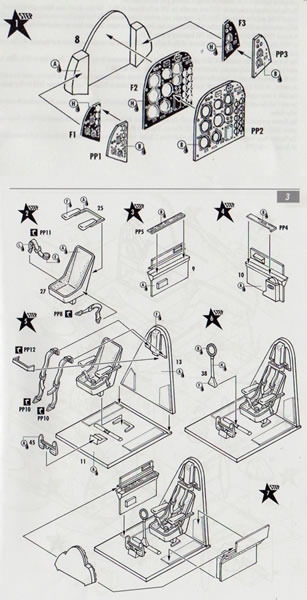
The surface detail is nicely done, with a combination of fine engraved panel lines and numerous raised reinforcement panels and other miscellaneous detail. However, the raised sections on the fuselage seem to be an attempt to represent a heavy concentration of rivet lines, as are apparent in the image linked to here, and are somewhat of a compromise and a little over-stated. This is an area where the Alley Cat kit differs, in that it simply has conventional engraved panel lines present in these areas, which is not quite correct either. It is possible to reduce the Sword detail by sanding or indeed remove it completely. It could be replaced by engraved lines, embossed rivets, or decal strip if you wish. I would be inclined to live with it as provided.
The raised strips on the under-surfaces of the outboard wings are certainly exaggerated when compared to this image. They are by comparison smaller and barely apparent on the Alley Cat kit. Again, these can be toned down, removed or left in place according to individual inclination and taste.
The air intake is possibly a bit soft in appearance, with a very slight lop-sided appearance to the lower portion where the intake divides like a peace-sign. This seems to be a combination of less than perfect mastering and limitations of limited-run moulding process. It is not a major issue however, and careful positioning of the prop blades will obscure the slight imperfections.
The clear parts are well done, as already mentioned, and aside from the pilot’s canopy include the radar operators’ potholes, and wing landing lights.
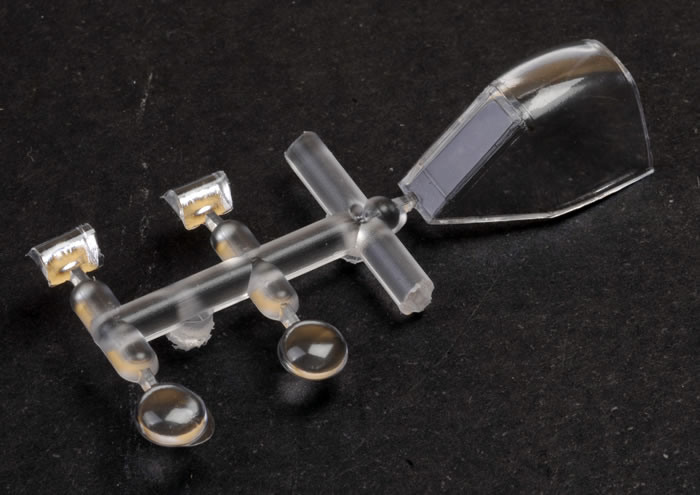
Wheel wells have a good amount of detail for the scale, and the undercarriage appears ok. Sword seem to have engineered the two four-blade contra-rotating props so that they can only be fitted in the correct sequence with the large spinner. There are numerous small injected details to add to the airframe, with some very finely moulded, such as the catapult hooks and pitots. There are also a few PE blade antennae to fit.
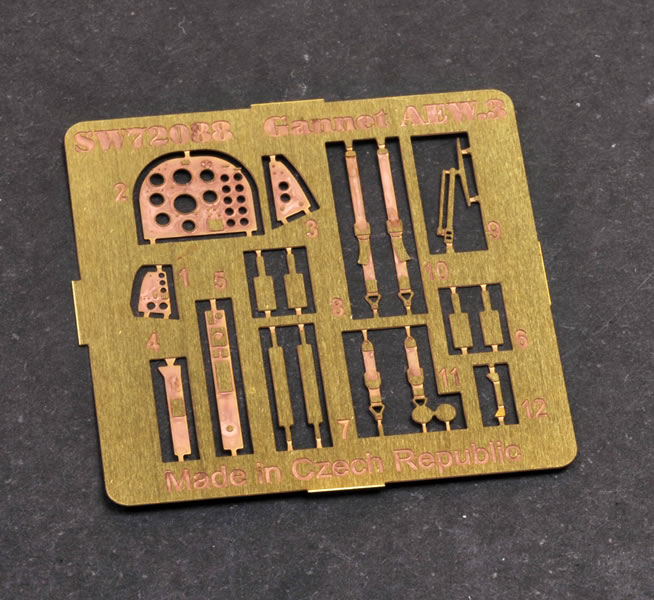
A pair of drop tanks is also provided along with sway-braces.
Overall, I should think that this kit should be an enjoyable one to build, provided you accept that its limited-run nature may demand some fettling here and there.
Marking Options
Techmod prints the decals, and these are well registered with what appears to be good opacity. I am sure they will prove to be excellent to apply based on my experience of this brand.
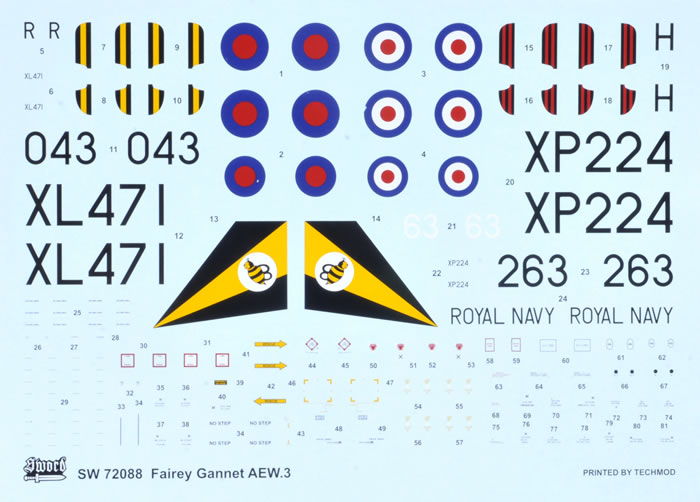
The instructions provide a page of four-view drawings with the national insignia and unit markings for each of the two schemes, with colour profiles on the box rear. The subjects covered are shown below:

If you want alternatives to the two kit schemes, you may wish to consider Alley Cat’s after-market sheet for the Gannet AEW.3 as it is still available
This is a very nicely executed kit of what is for me the best-looking Gannet (not hard! I hear you say).
Despite the slightly heavy-handed raised strips on the fuselage and wing undersides, it still ticks all of the right boxes. It has nice surface detail, better cockpit detail than is probably required, some very fine parts, clear instructions, and good decals. Perhaps the best part for some is the price, which means they can buy a kit that essentially equals the superb Alley Cat resin kit at just over a quarter of the cost. I highly recommend it.
Thanks to Sword Models for this review sample.
Review Text & Blue Background Images Copyright © 2015 by Mark Davies
Page Created 1 July, 2015
Last updated
2 July, 2015
Back to HyperScale Main Page

|
